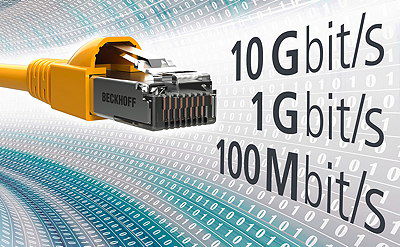- Home » News » Technology News
Beckhoff cranks EtherCat speeds up to 10Gbit/s

At the recent SPS IPC Drives show in Germany, Beckhoff announced the development of two new versions of EtherCat that will support Ethernet transmission rates of 1Gbit/s and 10Gbit/s. Known as EtherCat G and G10 (which is still at the proof-of-concept stage), the high-speed versions are aimed at data-intensive applications involving equipment such as machine vision, complex motion control systems and measuring equipment with high sampling rates.
Beckhoff also announced a branch controller for EtherCat G that will allow the efficient operation of multiple network segments in parallel. Although propagation delay times through devices will limit the real-world performance achievable by EtherCat G, the availability of the branch controllers will mean that the new technology will be able to deliver a two-to-sevenfold increase in performance compared to standard 100Mbit/s EtherCat, depending on the application.
Thomas Retting, Beckhoff’s EtherCat product manager, reports, for example, that it will be possible to process 128 servo axes on one segment in 34µs.
“EtherCAT G and G10 raise performance to entirely new levels that will enable our customers to build the best, highest-performing machinery in the world,” declares Beckhoff’s managing director, Hans Beckhoff.
“EtherCat G and G10 are not meant to replace the highly successful EtherCat standard based on 100Mbit/s Ethernet,” he adds. “The new performance levels are intended as system-compatible expansions.”
EtherCat G achieves its higher transmission speeds without needing to make any changes to the protocol or to the EtherCat master software. It will offer the same built-in diagnostics, precision synchronisation and “unrivalled” telegram processing on the fly. It also conforms to the IEEE 802.3 Ethernet standard.
EtherCat and EtherCat G can be combined on the same network, with EtherCat G slaves operating in a 100Mbit/s network, and vice versa. In either case, EtherCat G equipment will fall back to the 100Mbit/s rate.

However, with the new branch controllers, EtherCat branches can be set up to allow parallel operation of 100Mbit/s segments within a 1Gbit/s network by converting transmission rates. For instance, the new EK1400 EtherCat G Coupler can create a branch that steps the data rate down from 1Gbit/s to 100Mbit/s, allowing standard EtherCat terminals to be used as I/Os on an EtherCAT G network.
Another advantage of the branch controllers is that they minimise propagation delays. Beckhoff’s new CU14xx branch controllers will interconnect EtherCat and EtherCat G segments and support parallel operation. This will reduce signal propagation times “significantly” and, thus, shorten communication and cycle times, because telegrams coming back from a segment travel directly from the branch controller to the master at 1Gbit/s, independently of other network segments.
Beckhoff says that standard 100Mbit/s EtherCat will remain more than sufficient for most applications.
• EtherCat G and G10 are not yet official EtherCat Technology Group technologies, but ETG executive director Martin Rostan expects that Beckhoff will make them available to the ETG during 2019, and is “confident” that organisation will accept the offer. He adds that the technologies will widen the applications for EtherCat, but predicts that in five years’ time, 95% of EtherCat applications will still be using standard 100Mbit/s EtherCat.





